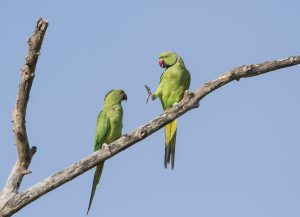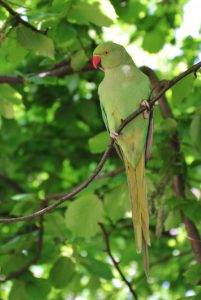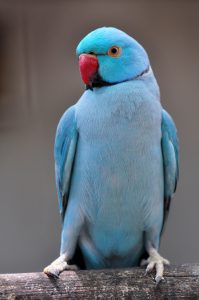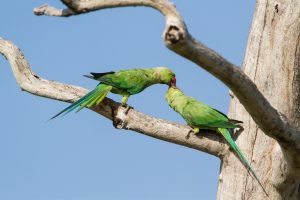Warm weather, the leaves bursting from tree branches, calming sun set and silver Rhine – those are my first memories of Bonn. But there is something more. A beautiful animal. And whenever I see it I go back in time to the moment I arrived to Bonn right before starting my PhD in March 2014. My husband and I were taking a pleasant walk on the Rhine:
“I think I saw a green parakeet”
“I think you should have your eyes checked”
More or less that was the conversation I had with him at that time. My reasoning was: I’m Polish. There are no tropical birds in Poland. Germany is a western neighbor of Poland. No parakeets in Poland – no parakeets in Germany. I was wrong.
So, what are these leaf-colored animals?

Rose-ringed parakeets are dimorphic: females have no or pale ring around the neck and males have red or black ring (image from colourbox.com/ Utopia_88)
Their name is rose-ringed parakeet (Psittacula krameri in Latin and Halsbandsittich in German)1,2 Here you can see them in action. As you’ve probably noticed on the pictures, it wasn’t enough that they are green. To please the ladies, parakeet guys combine their green jacket with a red necklace (or black if they are heavy metal fans). I kind of like that in the bird world the guys often have to look better than the girls. But back to our birds: they are parakeets – a small version of a parrot with long tail5. Adorable! Additionally they are gregarious. So they like meeting in the evening on their favorite tree8 and drink their India pale ale with other parakeets. And although, India pale ale is not from India (but was exported there by the British)9, the rose ringed parakeet is. Their original living environment is in fact middle Africa and southern Asia1. And as much as I like them here, they are not always loved at home, because they fly in flocks to the local farms and eat seeds, buds, fruits, nuts etc. without paying.
Now, some basic questions come to mind:
If they are originally from tropics, what are they doing here?

There’s supposed to be a parakeet here 😉 (image from colourbox.com/ Paulo Vitor Martins)
They became feral7. This means they were domesticated, but went wild (feral actually sounds like a good word to describe a usually calm person who gets crazy after drinking: “Last night Johnny went feral”). It happened to many species: starting from cats and dogs, through cows and horses, and ending with plants like alfalfa. But who released the parakeets in NRW? It could be ancient Romans as they lived here and they are known to have kept our little friends as pets. But according to the resources, it seems that they have been here less than 60 years. Some suspicion falls on Cologne Zoo3,8, but nothing is certain I think. It has to be noted of course that as feral animals they may pose danger to the native species11. I must admit that I saw one youtube video of a pigeon in a black hoodie sitting in a dark room telling the story how a green parakeet stole his favorite place on a branch (just a joke – don’t look for a link), but most of the concerns I found in the internet regarded rose-ringed parakeets doing their “business” everywhere10.
Where can you see them in Bonn?
If you take a stroll on the Rhine you can hear their parakeet chirp and if you look up you will see their green bellies carried in the air by gray-framed wings. You can try to look in the trees too but it’s like trying to find that one 5 cent coin among all the 2 and 1 cent coins you happened to have in your wallet. Possible. But difficult.
Another place I know of is Alter Friedhof6 – the cemetery next to the City Hall. By the way Alter Friedhof is worth visiting anyway because of its beauty and famous people who rest here in peace or in parakeet’s voices. Actually, Bonn is not the only city chosen by the rose-ringed parakeets as home. They like to hang out in the cities close to the Rhine.
Why do they have such an awesome color?

Rose-ringed parakeets that have mutated psittacine appear blue (image from colourbox.com)
First of all, birds can see colors. That is why they are so colorful. And apparently, there are two ways that the little beaked creatures can make their feathers so vibrant: pigments or light refraction. Many birds can acquire carotenoids (red and yellow color) by eating plants. That’s pretty awesome, but parrots decided that they don’t want to pay too much attention to their diet, so they produce their yellow and red by themselves. The pigment is called psittacine17 (psittacidae equals parrots in Latin). Thus, in the case of rose ringed parakeet, the green color is created thanks to the red and yellow psittacine overlying blue-reflecting feathers. Now the blue layer is not actually blue, but is an effect of little air bubbles (spongy zone) in the structure of the feather that make the plumage appear blue.15,16,18 The blue color is sometimes not completely covered by psittacine on the tail.
Are there any other fun facts about these feathery creatures?
Mimicry1
They can imitate human voice. So watch out and better not talk about your dirty little secrets near the Rhine.
Lack of Tristetraprolin (TTP)19
Tristetraprolin is an anti-inflammatory molecule that inhibits TNF-α. Mice that can’t produce TTP suffer from severe inflammation. Mammals have it, reptiles and amphibians have it. Birds don’t have it, but apparently they don’t care.
Puberty14

Rose-ringed parakeet going through adolescence (image from colourbox.com)
Like some other pet parrots they can go through difficult adolescence stage (bluffing). Except instead of slamming the doors, yelling and angrily stomping around, they bite, hiss, and avoid interaction.
Flying faster than the speed limit12
There are not too many things that can surprise a police officer in Bonn. However, in May 2016 a rose-ringed parakeet was caught on the radar while flying 43km/h in a 30km/h zone. I don’t know how the poor bird will pay his speeding ticket…
Whenever I see the green speck on the blue sky of Bonn I am reminded that life (professional and private) is full of beautiful surprises. Ok, that sounds a bit cheesy, but it is true.
References:
- https://en.wikipedia.org/wiki/Rose-ringed_parakeet
- https://de.wikipedia.org/wiki/Halsbandsittich
- https://www.robert-c-klotz.de/vogelarten/halsbandsittich/
- https://www.youtube.com/watch?v=Sy7ixmTUhFw
- https://en.wikipedia.org/wiki/Parakeet
- https://en.wikipedia.org/wiki/Alter_Friedhof,_Bonn
- https://en.wikipedia.org/wiki/Feral_animal
- http://www.naju-wiki.de/index.php/Halsbandsittich
- https://en.wikipedia.org/wiki/India_pale_ale
- http://www.rundschau-online.de/region/koeln/papageien-stadt-koeln-will-halsbandsittich-loswerden-26144638
- http://www.sueddeutsche.de/wissen/halsbandsittiche-in-deutschland-invasion-der-gruenen-papageien-1.1244859
- https://www.welt.de/vermischtes/kurioses/article155301266/Papagei-als-Temposuender-in-30er-Zone-unterwegs.html
- https://www.youtube.com/watch?v=U1RG3MWDGFE
- https://www.thespruce.com/bluffing-biting-behavior-in-parrots-390306
- https://academy.allaboutbirds.org/how-birds-make-colorful-feathers/
- http://www.parrotparrot.com/articles/fun-play/what-gives-feathers-their-color/
- http://www.parrotparrot.com/articles/fun-play/what-gives-feathers-their-color/
- http://www.neitokakadut.com/en/genetics/color-birth-and-pigment-types
- https://www.ncbi.nlm.nih.gov/pubmed/23904106
featured image from colourbox.com

Author: Kasia Jobin
